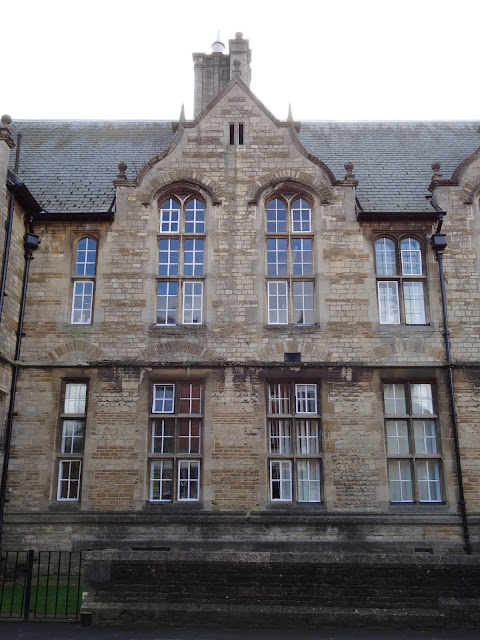Anyway the real subject of this post is the visit we made on Thursday to Thorney, in the Fenland just east of Peterborough. I had been there before as a child to the zoo that then existed there. I haven't been back since, except passing through on the top of a double decker heading for King's Lynn, but it has always intrigued me.
Like Crowland to the north, Thorney is built on a fen 'island' and is the site of an ancient monastic community. Its oldest recorded name is 'Ancarrig' - the isle of the anchorites - referring to the community traditionally founded by Saxulf Abbot of Peterborough c.662. In 870 it was sacked by the Vikings and three of the hermits there, Tancred, Tothred & Tova, were martyred. The island reverted to wilderness and the name changed over time to Thorney to reflect its abandonment - the island of thorns. In 972 a new monastery, Benedictine, was founded by St Ethelwold. It soon began to amass a massive collection of relics, and became a place of pilgrimage. In the 1530s the monastery was dissolved and abandoned, the stone being quickly carted off to use in Cambridge.
I was not a disappointed pilgrim. The village and the church are especially attractive, more like a village in the Great Limestone Belt to the west than a fenland community. This is due mainly to the fact that Thorney was an estate village, owing its appearance to the Dukes of Bedford. Rows of pretty cottages line the main street. Around the remains of the abbey are rather muscular Victorian Gothic cottages and shops, and to the south of the church is a village green lined with older, grander houses. The church itself is basically Norman (1085-1128), built under Abbot Guenther. Sadly all that remains of the church are the west front and the five western most bays of the nave. The church originally was nearly 300ft long. The nave has been stripped of clerestory and aisles. In 1638, when the local fens were being drained to form the Bedford Level, the church was restored to use, apparently by Inigo Jones. The attribution though might be apocryphal. The west window and door, and the plaster vault inside date from that period. In the 1840-1 Edward Blore added a chancel of sorts - a crossing and transepts in a monumental, rather Germanic, Romanesque - making the church 'T' shaped in plan. The churchyard is crammed with monuments, the Georgian ones very distinctive, the relief sculpture being deeply cut and often bearing a representation of the Lamb of God.
I was not a disappointed pilgrim. The village and the church are especially attractive, more like a village in the Great Limestone Belt to the west than a fenland community. This is due mainly to the fact that Thorney was an estate village, owing its appearance to the Dukes of Bedford. Rows of pretty cottages line the main street. Around the remains of the abbey are rather muscular Victorian Gothic cottages and shops, and to the south of the church is a village green lined with older, grander houses. The church itself is basically Norman (1085-1128), built under Abbot Guenther. Sadly all that remains of the church are the west front and the five western most bays of the nave. The church originally was nearly 300ft long. The nave has been stripped of clerestory and aisles. In 1638, when the local fens were being drained to form the Bedford Level, the church was restored to use, apparently by Inigo Jones. The attribution though might be apocryphal. The west window and door, and the plaster vault inside date from that period. In the 1840-1 Edward Blore added a chancel of sorts - a crossing and transepts in a monumental, rather Germanic, Romanesque - making the church 'T' shaped in plan. The churchyard is crammed with monuments, the Georgian ones very distinctive, the relief sculpture being deeply cut and often bearing a representation of the Lamb of God.



























































